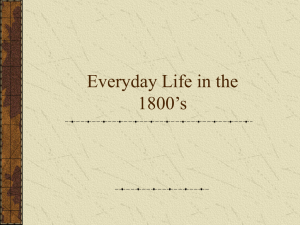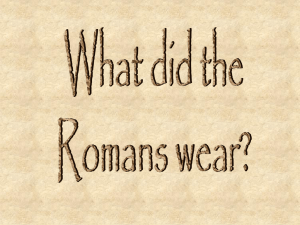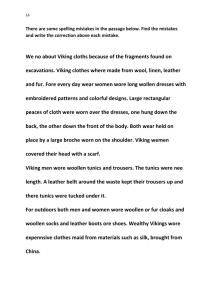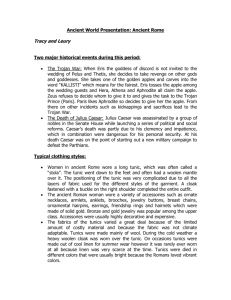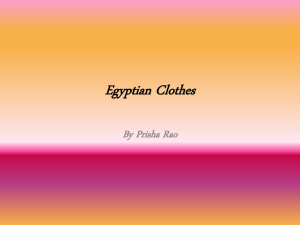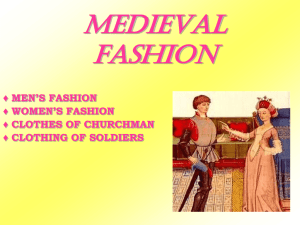Medieval Fashion Guide
advertisement
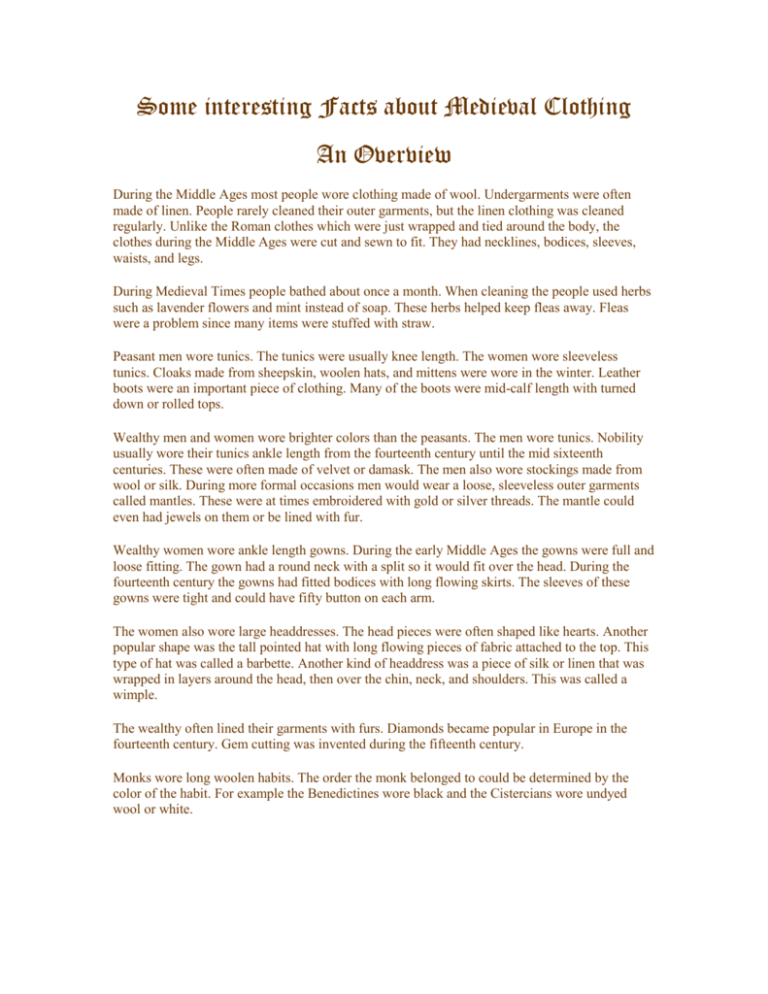
Some interesting Facts about Medieval Clothing An Overview During the Middle Ages most people wore clothing made of wool. Undergarments were often made of linen. People rarely cleaned their outer garments, but the linen clothing was cleaned regularly. Unlike the Roman clothes which were just wrapped and tied around the body, the clothes during the Middle Ages were cut and sewn to fit. They had necklines, bodices, sleeves, waists, and legs. During Medieval Times people bathed about once a month. When cleaning the people used herbs such as lavender flowers and mint instead of soap. These herbs helped keep fleas away. Fleas were a problem since many items were stuffed with straw. Peasant men wore tunics. The tunics were usually knee length. The women wore sleeveless tunics. Cloaks made from sheepskin, woolen hats, and mittens were wore in the winter. Leather boots were an important piece of clothing. Many of the boots were mid-calf length with turned down or rolled tops. Wealthy men and women wore brighter colors than the peasants. The men wore tunics. Nobility usually wore their tunics ankle length from the fourteenth century until the mid sixteenth centuries. These were often made of velvet or damask. The men also wore stockings made from wool or silk. During more formal occasions men would wear a loose, sleeveless outer garments called mantles. These were at times embroidered with gold or silver threads. The mantle could even had jewels on them or be lined with fur. Wealthy women wore ankle length gowns. During the early Middle Ages the gowns were full and loose fitting. The gown had a round neck with a split so it would fit over the head. During the fourteenth century the gowns had fitted bodices with long flowing skirts. The sleeves of these gowns were tight and could have fifty button on each arm. The women also wore large headdresses. The head pieces were often shaped like hearts. Another popular shape was the tall pointed hat with long flowing pieces of fabric attached to the top. This type of hat was called a barbette. Another kind of headdress was a piece of silk or linen that was wrapped in layers around the head, then over the chin, neck, and shoulders. This was called a wimple. The wealthy often lined their garments with furs. Diamonds became popular in Europe in the fourteenth century. Gem cutting was invented during the fifteenth century. Monks wore long woolen habits. The order the monk belonged to could be determined by the color of the habit. For example the Benedictines wore black and the Cistercians wore undyed wool or white. Women’s Fashion Peasant Women ne of the lowest classes was that of the peasant. Women made clothes for their family and themselves. The materials they used were either that of wool, linen, leather, or whatever else they could afford. Most often they wore wool, which must have been very itchy. Peasant women wore calf length t-gowns of dull coloring. These dresses were known as chatelaines and of were of plain colors such as gray, brown, dark blue and red. The gowns were worn with sleeveless tunics and wimples to cover their hair. They usually only had two or three dresses at most. Peasant women often did not own shoes as they could not afford them. Noble Women ithin the class of the Nobles lay the most intricate articles of medieval fashion. Fine ankle length gowns were made exquisitely from the finest materials and of ankle length. After the Crusades, an influx of Eastern and Oriental materials such as silk, velvet, satin, damasks, and brocades allowed for even a wider selection. The colors of their dresses were also brighter than that of lower classes that had apparel dull in color. Women preferred strong colors such as red, sky blue, leaf green and white, sometimes all in one dress. In order to get even brighter colors, dyes were imported creating strong reds, indigo, and pure green. Because of the wealth noblewoman possessed, they were also able to have personal tailors to produce their clothes and either embroider or decorate them with jewels. In order to adhere to the new fashion of tight clothing to show the curves of the body, women began using girdle type pieces to pull tight their tops and create a long-waist appearance. The girdle was often worn on the outside of clothing to also hitch up an outer tunic enough to show the color of the under dress/tunic. Women’s clothing were not to be as tight fitting as the men until the 15th century, when tight sleeves, tight fitting, and full skirted took its place in fashion. Everything was also long, full, and trailing to show wealth and to cover the arms and ankles. The hair of a noblewoman was a very delicate thing. It was a significant sign of beauty, and many noblewomen had a large selection of headdresses and veils to embrace this beauty. The hair of medieval women was often sun bleached or even false because Italy blonde hair was praised as a form of beauty. These attempts at beauty were not always approved as the church said sun bleaching could damage the brain and imperil the soul. Headdresses varied again by wealth and the century, but a primary hat of women in the 15th was the henin . A henin is a heart or V shaped hat draped with flowing fabric. After marriage women would raise their hair into a large chignon and add a bandeau or crown of flowers. Also noblewomen fancied wearing gold nets and circlets or even placing gold dust in their hair. The undergarments of a medieval people are not certain as cotton was considered a luxury item and not invented until the 12th century in France. After that time it is possible that women and men would have had cotton undergarments but linen was used for any underclothes that were worn. However, even linen was hard to produce, therefore many people just did without. A noblewoman may have worn the undergarment known as a cotte. If she was wealthy enough, she would most likely have undergarments made of either silk or linen. However, her wealth all depended on her husband. Women of the Middle Ages were seen as property. Peasant women did not have to worry as much, for their worth was not much since their families had little or no money or property. However noblewomen generally came from rich families who owned property that would be passed on to her and her future husband. To show whom a woman “belonged to” they wore either their father or husband’s coat of arms on her clothing. Men’s Fashions Peasant Men he clothing of a peasant man had nothing to do with fashion. Clothing’s purpose for them was to keep them warm.. Peasant women made the clothing of home spun wool or linen (if enough money was available). Everything from undergarments to their tunic was made of wool. Also, to distinguish their class and wealth, the cut was short calf length and the fabric often dark. Underneath, they wore trousers, hose or simply wrapped their legs with strips of cloth. An example of a peasant outfit would be a wool or linen shirt, leather flask, and leggings. To carry goods, men would, like women, sling a piece of cloth over their shoulder and tie it around their waist. On top their heads would either be a straw hat in the summer of a felt hat in the winter. A tailhead hat was also a common hat of peasants as well. Because peasants lacked great amounts of money, the men only had one or two outfits and perhaps a cloak. Some peasants had the luxury of owning gloves and shoes for the winter, but very few did, and the quality of what they did own was no where near that of the nobility or other classes above them. Knights ften of noble blood, a knight was very respected and considered of wealthy status. They would most commonly wear a coat of chain mail with a tunic over the top. The tunics themselves would often be divided into sections, often in a checkerboard pattern with alternating colors of black and white. To show they were knights, the tunic would also have the coat of arms imprinted on it, of the nobleman to whom he served. Finally, this would all be worn over tights and a belt over the tunic would secure the outfit together. Later in the 13th century, plate armor became popular and replaced the over tunic. Noblemen oblemen governed feudal estates. They were the wealthy, well respected individuals and with that came the finest of medieval fashion. Brighter jackets, better materials, and longer jacket lengths were just a few of the wealthy determining factors. The most popular materials were velvet and damask with trimmings and linings made of fur. The large part of the beginning of the Middle Ages, men wore trousers mad of wool underneath their tunics. Then, as the middle ages progress, fashion changed and men switched to a very tight set of leggings known as hose or stockings. As for the tunic, it was usually ankle length and even down to the floor when one attended a special occasion or a party. Younger noblemen wore tunics of shorter length, but all were of bright colors and ornamented with jewels. Something that noblemen had that many other men didn't was shoes! Some peasant men owned homemade shoes for winter, but noblemen owned elaborate shoes made of fine leathers and often of the color red. Also the shoes would be decorated with jewels, especially pearls. Some of the most unique shoes of the era were called poulatins. These shoes would be very pointy, almost resembling elf shoes. The points got to be so long that one might have to tie the point around the ankle just to walk. Contributing to this lengthy situation, was a custom that was enacted for a short time which stated the longer the point of the shoe the more wealthy. Clergy Bishops Bishops wore three main pieces of clothing. 1. 2. 3. 4. A simple white gown or alb A tunic or chasuble A circle cape or a cope a triangular hat called a miter Since Bishops were high ranking in the clergy they wore some of the finest of fabrics of the clergy as well. Many nobles became bishops because of the high rank in the church which was more suitable for a man of wealth than that of a poverty sworn monk .Because most bishops were wealthy, they dressed lavishly and much the same as a feudal lord. The clergy's ranks themselves depended on the length and fabric that each wore. Silks and velvets were not uncommon for bishops. Also their cape was ankle length and often had embroidered edges. Another distinguishing factor was that atop their head, a bishop would wear a hat known as a miter. Monks Monks, like Nuns had sworn their life to poverty. It was the simplest of fashion much like that of a peasant man. in fact many monks were sons of peasant men. The fabrics were usually homespun wool and not of finer quality. A normal outfit of a monk was a t-gown with a cowl collar known as a habit. Twine served as a belt and a "linen head" or coif hat was worn to keep their heads worn. The color of a monk's apparel was dull and varied with each monastery. However, most were either black or brown. Dominican friars wore white woolen robes while Benedictines wore black. Children ost young children, boys and girls wore clothing that resembled that of their parents. Depending on their parents class and wealth depended on the fabric of the material they wore. However, most boys wore wool or linen tunics with hose underneath. To distinguish they were still young boys, they wore hats called a hound. ypically, young girls wore bonnets to distinguish themselves. Their dresses were made of linen or wool and colors usually modeled after their parents since wealth determined their status and wealth. Once again brighter fabrics represented their parent’s wealth. Young girls were not young for long. The youngest a girl could marry by law was 12 and many arranged marriages put girls in marriages by the time they were 16. Before marriage, to establish whom the girls "belonged" to, young girls had their family crest on their clothing. This characteristic is also seen in noblewomen who wear the crest of their husband as opposed to their father.
